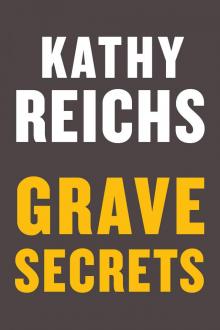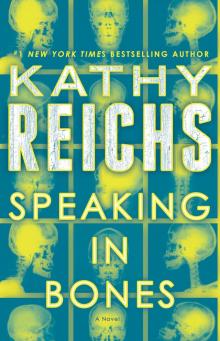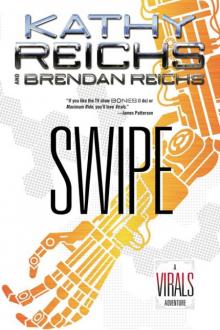- Home
- Kathy Reichs
A Conspiracy of Bones Page 8
A Conspiracy of Bones Read online
Page 8
“Wait.” My eyes whipped to Slidell. “You found indented writing?”
“Near the mumbo jumbo about the sinking ship.”
“Ferry,” I corrected. Needless, but I was jazzed. “So a sheet was missing from above that first page?”
“Thought I spotted grooves, angled my flash across ’em. Called up here.”
Peppers used her ID to swipe us through a set of security doors, again to enter the Questioned Documents section. Inside, she went directly to a blue-and-gray box with a flat white top and the letters ESDA on the front. Looked like a small photocopier except for a large roll of clear Mylar sheeting to one side.
“Can we stick to the basics?” Slidell, not at all subtly checking his watch.
Peppers ignored him. “I used a technique called electrostatic detection. Sounds high-tech, but it’s not rocket science.”
My mind translated the letters on the machine. Electro Static Detection Apparatus.
“The specimen needed some humidification. Not much. It was an outer page, and the trunk environment wasn’t too dry.” Peppers hit a button, and the apparatus began whirring lustily. “Vacuum pump.” Loud enough to be heard over the noise.
I nodded.
Peppers placed a paper on the platen, stretched Mylar across it, and snipped the edge free from the roll. After hitting a second button labeled corona, she ran a long, rectangular wand back and forth above the Mylar.
“The corona sends high-voltage static charges onto the paper.” Not shouting but close. “The positive charges from the wand are preferentially attracted to the indentations. I’m simplifying.”
I nodded again.
After turning off the corona, Peppers tilted the platen and shook black powder from a canister onto the Mylar. “The toner is similar to that used in dry-process photocopy machines. It’s negatively charged.”
I nodded again, feeling like a bobblehead. But I didn’t want to yell.
“The areas of the document containing the higher static electric charge will retain more of the toner, resulting in dark deposits in the indentations.”
A few seconds of shaking to distribute and clear off the excess toner, then she killed the vacuum pump. The room went mercifully quiet. “Take a look.”
I stepped closer.
On the paper, in squiggly black script, were the words Crime Scene Do Not Enter. I looked a question at Peppers.
“I couldn’t use the real evidence to demo the process for you, so I made this mock-up. When finished with my actual analysis, I photographed and preserved the detective’s specimen.”
Chiclet smile. Not returned by Slidell.
“Have a look.”
I followed Peppers to a side counter. The notebook page was there, solo now, covered with a sheet of adhesive-backed clear plastic. Through the plastic, I could read the Latvian words Nogrimšanas traǵēdija. The name Felix Vodyanov.
Beside the words and name, three lines of writing not visible before. Fierce capitals and numerals.
I read them.
And felt a chill wash over my body.
9
The first line was a sequence of ten digits beginning with 704. The Charlotte area code.
The second line was also a telephone number.
The room had dissolved into a soundless whiteout. All I saw were those tiny black numerals, the grayness of the page roaring around them.
My mind was a maelstrom. Confusion. Disbelief. Fear.
For a moment, I felt I was floating. Then the stab of dread. Another migraine? No, this was different.
I blinked. Turned. Slidell and Peppers were watching me, identical frowns on their faces.
“That’s my mobile number.” Barely audible.
“It is,” Slidell said flatly.
“Sonofabitch.” Not my best. But I felt violated. As though a stranger had hacked my email or pawed through my underwear drawer.
“You put yourself out there for any of this social-media hooey? He Harmony? Snatch Match? Some egghead chat-room jabbering bones?”
I have years of practice in ignoring Slidell. In letting his callous commentary roll over me. Usually, the experience works to my advantage. Not at that moment.
“Holy Jesus Christ Almighty!” I exploded.
Slidell raised placating palms. “Look. This wanker had your number. John Ito or whoever the fuck left that car. There’s lots of ways that could play.”
“Don’t ever ask me a question like that again.” Anger had totally routed the fear.
“Does the third line mean anything?” Peppers asked.
I looked at the letter-number combo. JCOLE1013. Shook my head no.
A small silence. Then Peppers handed Slidell two prints. “I’ll keep the original page here, preserve it properly.”
Slidell grunted and headed for the door.
“Is he always this pleasant?” Tipping her head toward Skinny’s retreating back.
“He’s a boor but a good detective. Thanks for doing this.”
Downstairs in the squad room, the boor checked one of Peppers’s pics, then punched keys on his landline. The tinny sound of a connection came through the speaker. One ring, then a message, the words low and warbly, as though spoken underwater.
“Leave it. Short like this.”
A long beep followed by expectant silence.
Slidell disconnected with an irritated jab.
“Can you get someone to trace the number?” I asked.
A one-shoulder shrug.
“Why not?”
“The phone’s probably a burner, scored at a Walmart, chucked into a dumpster the next day.”
“Voice mail is still working.”
“Waste of time.”
I knew the basis of Slidell’s resistance. He was an outsider now. Enjoyed squad-room space only because of his long tenure and his volunteer work with the cold-case unit down the hall. He could call in only so many favors.
I was about to say something snarky. Which would have sent us into one of our death-battle spirals. Instead, I took a deep, calming breath and dropped into the chair opposite Slidell’s.
“The owner of the Hyundai had two numbers—”
“The owner of the notebook.”
“The one you just dialed,” I said, gesturing at Slidell’s phone. “And mine. The Hyundai’s owner may or may not be John Ito. Or Felix Vodyanov.”
“Or Buck Baker’s great-aunt Maude.”
I hadn’t a clue who that was. “The Hyundai’s owner may or may not have turned up dead and become hog feed in Cleveland County.”
Slidell arranged himself more comfortably. Loosened his already loose tie, hooked a heel onto an open desk drawer, tipped his chair onto its rear legs, and began rocking slowly back and forth. But he was listening.
“You get any calls from unknown numbers lately?” he asked.
“I get dozens of calls from unknown numbers. Telemarketers trying to sell me insurance or roofing repair. I don’t reply to the voice mail.”
But I followed Slidell’s thinking.
Pulling my iPhone from my purse, I scrolled backward in time, checking the red listings indicating missed calls. Yesterday. Saturday. Wednesday.
Friday. June 22. Area code 681.
I switched to Google. Verified the call’s origin.
“A week ago Friday, someone rang me from a West Virginia exchange. I opened my voice mail to check that date. “The caller left no message.”
“The Hyundai was registered in West Virginia,” Slidell said.
Our eyes met, mine seeking permission. Slidell nodded. I tapped the number. Put my phone on speaker and laid it on the desk.
Two rings, then a voice, robotic, perhaps mechanically distorted to disguise the speaker.
“Record your name, the date and time, and a brief message.”
I looked a question at Slidell. He gave a thumbs-up.
“I’m sorry I missed your call. Please try me again. You have my number.” Disconnect. To Slidell. “Reach ou
t to the local guy?”
“Sure.” Flipping me the second of Peppers’s prints.
I read the recovered number, dialed. Got the same recording as Slidell. Did as instructed.
“I need to speak with you concerning a mutual friend. You know where to reach me.” Disconnect.
My gaze slid back to Slidell. He was studying Peppers’s photo, fingers drumming riffs on the desktop.
“Any hallelujahs on this third line?” he asked.
JCOLE1013.
I manipulated in my head, moving letters and numbers like pieces on a board. Separated the alphabetic from the numeric. Set the first pair of digits apart from the second. Split off one letter at a time. One numeral. Recombined them in various ways.
At one point, I heard Slidell lean back and resume his precarious oscillation.
JCOLE? A name? Wasn’t there a hip-hop artist named J. Cole?
10-13. A date? October 2013?
Across from me, Slidell was playing the same game.
The squad room quieted as detectives drifted off to dinner, to interrogations, to promising or tenuous leads. Overhead, the fluorescent bars buzzed softly. Across from me, Slidell’s chair groaned in undulating protest.
Abruptly, the grating stopped, and the chair’s front legs smacked the tile. “Who was that kid went missing?”
I looked up. Slidell’s eyes were on the print, brows angled into a bushy V.
“What kid?” I asked.
“Maybe four, five years ago.” Maybe 2013.
Like many in my line of work, I carry a roster of heartache in my brain. A wrenchingly painful catalog of dead and lost children. There was no need to thumb through the names. Slidell’s reference roared home instantly.
“Jahaan Cole.”
One or two brain cells sizzled cruel. A face popped. The same face displayed on endless posters and news broadcasts. A child with caramel skin, laughing eyes, boisterous dreadlocks bound with bright pink beads.
“Wasn’t Cole nine when she went missing?” Slidell asked.
We both did the math. Born 2004. Vanished October 10, 2013.
JCOLE1013.
My mouth suddenly tasted like ash.
Jahaan Cole was last seen leaving home to return a book to a neighborhood library stand at the end of her block, Laura Ingalls Wilder’s Little House on the Prairie. When Jahaan failed to return home, Brightie Cole phoned 911 to report her daughter missing. The book was found the following day on a rural highway eight miles from the Cole home. Jahaan’s hair bow turned up five weeks later.
The media staged their usual circus. With nothing new to report, they eventually folded their tents and scurried off.
Nine months after Jahaan’s disappearance, fragmentary remains came to the MCME. The news machine kicked back into gear. Until I determined that the bones were those of Vulpes vulpes. A red fox.
Six months after the fox fiasco, I traveled with a recovery team to a farmer’s field in Gaston County. When I close my eyes, I can still feel the weight of the afternoon heat on my skin. Smell the mowed hay and see the moths swirling in the dusty sunlight.
Again, breathless anticipation. The bones were human but those of an elderly male. There was a brief flurry of coverage, then the cameras and mics moved on to other tales of grief. While disappointed at the lack of closure, I was gratified that there was still hope for life.
The case was now colder than a glacial lake. Features aired on the anniversary of Jahaan’s disappearance. The media contacted me requesting interviews. The old photo was trotted out. A few calls would come in, lead nowhere. Jahaan Cole remained an MP. Missing person.
“Why the fuck would John Ito jot your number and notes about a missing kid?” Slidell said quietly.
I ran my tongue over my teeth. Swallowed. Had the faceless man known something about the child that he’d wanted to tell me?
I had no answer.
* * *
Something startled me awake.
I’d been dreaming, another complex scenario involving tangled shadows and murky figures. It took me a moment to disengage and figure out where I was.
Birdie? Running an arm over the covers without finding a cat.
Heart banging, I listened for noises on the first floor. Down the hall. Heard nothing but the familiar settling of the annex.
Digits glowed teal on the bedside table. 2:47. Sleep had been elusive. And brief. I doubted it would come again.
Still, I tried.
Turning my back to the clock, I closed my eyes.
And saw the photos I’d snapped in the autopsy room. Those texted to me from an unknown source.
John Ito? Felix Vodyanov? Someone else?
The pummeling questions started anew.
How had the faceless man died? Had he hidden the Hyundai at Art’s salvage yard, hiked into the woods, and taken his own life? Had he met someone on the banks of Buffalo Creek? Had that person killed him?
If the faceless man had been murdered, who did it? How? Why? Had the killer driven the Hyundai? If so, why leave it at Art’s? Did the faceless man and his killer arrive together? If so, how had his killer departed? Did his death have anything to do with the Estonia disaster?
Round and round, in endless loops. Question after question. No answers.
I pictured the duffel locked in the Hyundai’s trunk. The spiral with its notes about biochemical weapons and a ferry disaster. The peculiar assemblage of tools. The delabeled clothing. The thumb drive with its Cyrillic identifier.
Would the thumb drive provide the breakthrough I was hoping for? Names? Addresses? Passwords for email accounts? Selfies snapped with a cell phone?
Files on top-secret SVR espionage operations? On Russian moles in the CIA?
Sweet Jesus in a romper. I was spending way too much time with Skinny.
Slidell had taken the lot. I’d agreed with his reasoning. The Cleveland County sheriff, if interested, would send the duffel and its contents to the CMPD forensic lab for analysis. A quick dust for prints, then he’d probably transfer the car to Charlotte as well. Slidell was simply speeding the investigatory process.
Slidell’s apparent about-face had surprised me. Why the sudden willingness to help with the faceless man? Animosity toward Sheriff Poston? Or did the change in attitude have to do with me?
The notebook had yielded an impression containing two numbers: one with a West Virginia area code and one for my mobile. The West Virginia number had dialed my phone within the past ten days. Was that it? Was Slidell motivated by some paternalistic notion that I needed protecting? The thought didn’t please me.
Had someone told Slidell about the aneurysm? The migraines? If so, who? That thought didn’t please me, either.
I got up and walked through the turquoise-lit darkness to the bathroom. A cold drink of water, then I stood, arms crossed, not moving, not listening, as facts and questions collided in my head.
The West Virginia number had called my iPhone on June 22. The date of my migraine nightmare and midnight walk. The night I’d been anxious about the trench-coated man.
But had Trench Coat actually been there? Or was he merely a headache aftereffect?
No. The man was real.
Had my instincts been correct? Had Trench Coat been watching me? Following me? Was he John Ito? Felix Vodyanov? Were the owner of the Hyundai and Trench Coat the same man?
Was the man prowling the grounds of Sharon Hall the faceless man found dead at Buffalo Creek? If so, he’d called me a week before his death. Why? Had he followed me home? Why? Clearly, the man wanted to make contact. To talk about what? The Estonia? Biochemical weapons? That made no sense. I knew nothing about either.
The page with the phone number impressions also contained a reference to a missing child. To one of my cases. What did the man know about Jahaan Cole’s disappearance?
Was that the reason for Slidell’s unexpected interest? Though inactive, Jahaan Cole’s file remained open. One of Slidell’s rare failures. As a cold case, she was
firmly on his turf.
That didn’t tally. We’d only learned of the indented code this evening, long after leaving Affordable Art’s. Something else had motivated Skinny.
Questions. No answers.
Sinking to the floor, I sat with knees up, shoulder blades to the vanity.
Jahaan Cole had gone missing long before the arrival of Margot Heavner. Back in the Larabee years.
I pictured my former boss, scrawny thin and overtanned from thousands of hours of long-distance running. Gray and still in the trauma surgical intensive-care unit.
Larabee and I had shared little of our personal lives. We didn’t hit the bars at day’s end or play on the same softball team. But we’d worked well together. His death had left me feeling like I was dangling over the edge of a gaping hole.
Tears burned the backs of my lids. I didn’t fight them. Hoped a good cry would vent the emotions thrashing inside me.
No go. I just sat there, blinking into space, mind ricocheting from question to question.
Did I regret my criticism of Heavner? My condemnation of her interviews with Nick Body? I’d taken so much blowback for that.
At least one easy answer. No, damn it to hell, no!
Heavner had leaked privileged information on a radio show hosted by a narcissistic crackpot. Information that had hurt the victim’s family and may have prevented the killer’s conviction.
Snatches of the exchange slithered free from the dark corner in which I’d stored them. Heavner discussing Hardin Symes’s autism. Body spewing bullshit about the hazards of vaccination. Body hyping the alarming number of child homicides and disappearances.
My eyes flew open. Until that moment, I’d forgotten. Or buried the memory so deeply it could find no slither room. I’d listened to Body interview Heavner one other time, more than a year after Hardin’s murder. Don’t recall my reason. Perhaps to see if Dr. Morgue was still abusing her office. In that broadcast, Body mentioned Jahaan Cole in a similar tirade about missing children. No lurid details, just one of many examples to support the ludicrous notion that the U.S. government was snatching kids.
Sitting on the cold tile, I felt chilled all over.

 Two Nights
Two Nights The Bone Collection: Four Novellas
The Bone Collection: Four Novellas Fatal Voyage
Fatal Voyage 206 Bones
206 Bones Bones to Ashes
Bones to Ashes Terminal
Terminal Monday Mourning
Monday Mourning Flash and Bones
Flash and Bones Cross Bones
Cross Bones Devil Bones
Devil Bones Break No Bones
Break No Bones Swamp Bones
Swamp Bones Déjà Dead
Déjà Dead Shock
Shock Spider Bones
Spider Bones Death Du Jour
Death Du Jour Grave Secrets
Grave Secrets Trace Evidence: A Virals Short Story Collection
Trace Evidence: A Virals Short Story Collection Bones on Ice
Bones on Ice The Bone Code
The Bone Code Bones in Her Pocket
Bones in Her Pocket Seizure:
Seizure: Speaking in Bones
Speaking in Bones Deadly Decisions
Deadly Decisions Spike
Spike Bones Never Lie
Bones Never Lie Bones of the Lost
Bones of the Lost Virals 03.5 - Swipe
Virals 03.5 - Swipe Exposure
Exposure A Conspiracy of Bones
A Conspiracy of Bones Shift (tory brennan)
Shift (tory brennan) Bones of the Lost: A Temperance Brennan Novel tb-16
Bones of the Lost: A Temperance Brennan Novel tb-16 Virals tb-1
Virals tb-1 Bones Are Forever tb-15
Bones Are Forever tb-15 Code tb-3
Code tb-3 Seizure tb-2
Seizure tb-2 Deadly Descisions
Deadly Descisions Spider Bones: A Novel
Spider Bones: A Novel